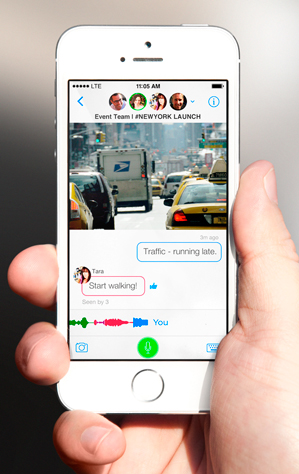An App That Wants You to Actually Talk on Your Phone
Ray Ozzie, former chief technology officer at Microsoft, has a theory about why people are more interested in texting or e-mailing than talking on the phone: he thinks they often despise hearing the phone ring. “They hate getting interrupted, not knowing what the priority or subject of the call is,” says Ozzie, a distinguished programmer who has a long history of creating collaboration software, including Lotus Notes.

In an effort to get people talking more, Ozzie and two cofounders spent the last two years building Talko, a communication app. Ozzie says the fact that other smartphone communication methods like texts, e-mails, and photos can be saved, searched, and forwarded to others makes the humble voice call less appealing—even though voice is sometimes the best medium for fast, efficient, and effective communications.
Talko, which rolls out today, focuses on group calls. Talko conversations can be tagged by subject and are recorded and stored by default. Because calls are preserved, you can bookmark bits of audio with notes to keep track of key points, and those notes can be seen by someone who couldn’t take part in the live discussion. You can also add hashtags to conversations so you can search by topic later on, and any member of a group can add audio messages to a discussion at another time.
Available initially for the iPhone, with an Android version to follow in several months, Talko incorporates text and photos as well, allowing you to send written messages to others while an audio call is in progress or share photos immediately as you take them.
In a demo of the app showing how a team of several people might use it, the display showed an annotated audio stream at the bottom of the screen and a busy but organized stream of texts and photos above. At the top of the display, bubbles containing team members’ photos indicated who was active in a call and who wasn’t.
Though the app is clearly focused on companies whose teams may want to use the app to keep organized, Ozzie believes consumers will also use it for things like planning trips or just maintaining a chronological, ongoing stream of mixed-media communication.
Ozzie uses it with his children, who live on opposite sides of the country, and he says it has cut down on occasional “guilt calls” they would make to him. “Now, it’s just so much more fluid,” he says. “People might just drop a photo in there and begin a conversation with a photo.”
Talko plans to make money by charging businesses, though it will also offer a free version that archives recorded calls for a week rather than permanently. The company has been testing the app for more than a year with hundreds of people at a number of different businesses.
In time, Ozzie hopes, Talko will do other things—automatically create written transcripts, for instance. He hopes the app can do this more precisely because each user is speaking into an individual phone, making it easier to separate the audio into different streams.
Ozzie can also envision, say, tagging people’s names as they’re mentioned in calls to allow the app to automatically create calendar appointments. But he’s wary of doing much with users’ data. “We’re being very conservative,” he says.
Keep Reading
Most Popular
Large language models can do jaw-dropping things. But nobody knows exactly why.
And that's a problem. Figuring it out is one of the biggest scientific puzzles of our time and a crucial step towards controlling more powerful future models.
How scientists traced a mysterious covid case back to six toilets
When wastewater surveillance turns into a hunt for a single infected individual, the ethics get tricky.
The problem with plug-in hybrids? Their drivers.
Plug-in hybrids are often sold as a transition to EVs, but new data from Europe shows we’re still underestimating the emissions they produce.
Stay connected
Get the latest updates from
MIT Technology Review
Discover special offers, top stories, upcoming events, and more.